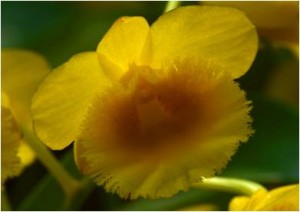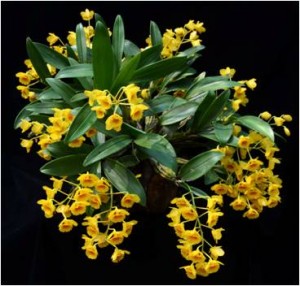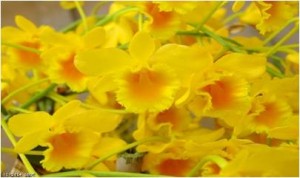Dendrobium chrysotoxum Lindl
Introduction: One of the beautiful Dendrobium species from North Eastern parts of India, producing an arching golden yellow colour flowers. Also known as the Golden Arch Dendrobium, it is a stunningly beautiful orchid. The plant is adored for it arching spikes of 4 cm waxy, bright orange fragrant flowers, with fringed lip.
Distribution: The species is native to Myanmar, Laos, Thailand, Vietnam, China, Eastern Himalayas and Assam in India, and Bangladesh at elevations of 700 to 1100 meters. It prefers cool to warm conditions.
Plant: The plant is a small sized with clustered, grooved, clavate or fusiform pseudobulbs of 12″ [30 cm] long. They are many angled, apically thickened and enveloped by a white, membranous sheath carrying. The pseudobulbs will have two (or even three) extended, oval shaped tough and leathery leaves. The leaves are oblong to lanceolate, coriaceous and acute. Blooming starts with late winter through spring. The 12″ [30 cm] pendulous inflorescence arises from nodes near the apex of the pseudobulb with highly fragrant up to 20 flowers of honey but are short lived. The flowers are yellow, the lip orange-and-yellow with a frilly edge.
Culture: These plants grow robustly during spring and summer and the growth stops altogether in late fall, but this species does not shed its leaves during the winter resting period. They need copious water and fertilizer while growing and less when mature. If well grown, it develops in to a very showy large specimen with large multi flowered clumps. The plant can be grown in a pot or basket with lots of water and fertiliser when in active growth. Plant needs a dry period as it approaches winter and the rest primes it for eventual flowering. During this ‘rest’ period the plant does not need regular water or fertiliser, watering can be done sparingly to ensure that the pseudobulb does not shrivel. The species prefers bright light for good growth and flower production and overall prefers intermediate temperatures.
Temperature. In their natural habitat, these orchids experience mild to warm daytime temperatures in spring and summer, and generally cooler temperatures in the winter. For most, the winter night temperatures range from about 8-10 C to about 12-14 C. It does best on the warmer end of the range.
Light. While actively growing, the plants require plenty of bright but filtered light. Many of these dendrobiums grow attached to deciduous trees in their native habitat, so they receive higher light in winter. Provide as much light as possible without the leaves getting scorched. You can grow this species under near-Vanda light levels. It is normal for the pseudobulbs of Den. chrysotoxum to be more yellow than green.
Water. Watering may be the most crucial element for successful culture of these orchids. Their native conditions are fairly wet during the late spring, summer and early fall. Rainfall can be quite heavy for a few months, but it tapers off in the late fall, and winter months are fairly dry. Water the plants regularly when they are actively growing; mounted plants can be watered daily if air circulation is good. When the new pseudobulbs have matured in the fall, gradually reduce watering, and allow the plant to dry between watering. In natural conditions, during this period, there’s some moisture in the form of dew or fog; a light watering every few days is all they need. It is normal for the pseudobulbs to shrivel somewhat during the resting period, but don’t allow the plant to dehydrate completely! During the coolest periods in winter, keep the plants fairly dry.
Fertilizer. These Dendrobiums benefit from regular feeding when they’re actively growing. Any balanced, water-soluble fertilizer can be used, diluted according to the recommendations. NPK 20-20-20 is a good option; feed once a week during the growing season. Reduce feeding in the fall and eliminate it completely when the plants are resting in the winter. Resume feeding when the plant begins to grow again.
Potting. Because most species in this group have upright pseudobulbs, the plants can be grown in pots or baskets, or mounted on a sturdy substrate like driftwood or teak root. Mounted plants need to be watered daily in summer if the air circulation is good. In a pot or basket, use a very well-drained epiphyte mix; prefer an inorganic product like expanded clay, as these orchids do best when their roots are undisturbed. Usually they are grown in baskets, or on mounts.
Pests & Diseases. These Dendrobiums have few really major pest problems. Snails and slugs may damage the leaves and canes, and occasionally during wet weather you may see some minor damage from leaf-spotting fungal diseases. Stale or decayed potting medium can lead to root problems, as with any potted orchids. Sometimes the problems of scale insects bother the plant.
If a mature plant doesn’t bloom in the spring, something in its environment is not correct. This may be too much water during resting; the plants need a little watering during this time but they must dry completely for two or three days between watering. .
References:
- Beginners Guide to Grow Orchide – K. S. Shashidhar.
Article by: Suresh Kalyanpur
Very informative article. Thank you.
The article was very good.
Will old pseudobulbs re bloom? I have a plant with one spike and 6 pseudobulbs that have bloomed buy no indication yet they will again.
Hi
Pseudobulbs has buds in the nodal areas and any bud which has remained dormant and not flowered may produce inflorescence when conditions are ideal. If they have already bloomed then very little chances of re bloom. However, we keep the pseudobulbs as it is till they wither and die by themselves as they continue to provide waters storage organs and nourishment to the plant . shashidhar
very interesting news letter, congrats, Shashdhar
I got this article after winter- watered regularly. Plants are healthy, I’ve three bunches- they are good looking plants.
How to propagate it ?
The plant can be propagated by division from a bigger mother plant with each division having 2-3 pseudobulbs. Other methods are tissue culture and seed culture in the laboratory using a nutritive media